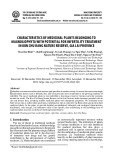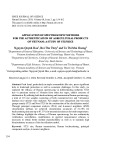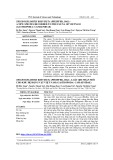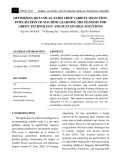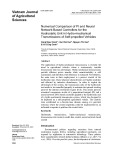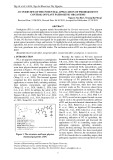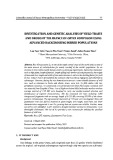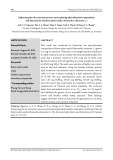
Vietnam Journal
of Agricultural
Sciences
ISSN 2588-1299
VJAS 2024; 7(2): 2135-2145
https://doi.org/10.31817/vjas.2024.7.2.04
https://vjas.vnua.edu.vn/
2135
Received: August 7, 2023
Accepted: May 10, 2024
Correspondence to
ntthao81@vnua.edu.vn
A New Score Function of IFSs and its
Application in the Evaluation of Software
Quality
Ngoc Minh Chau, Nguyen Xuan Thao & Nguyen Thi Thao*
Faculty of Information Technology, Vietnam National University of Agriculture, Hanoi
131000, Vietnam
Abstract
The score function is used to compare intutionistic fuzzy numbers. In
this paper, a novel score function of intuitionistic fuzzy sets (IFSs) is
investigated. The novel score function was constructed by combining
the polynomial and exponential functions working on the degree of
membership and degree of non-membership of intuitionistic fuzzy
sets. Then, the newly obtained measure overcomes the limitations of
some existing score functions. Next, we applied the new measure to
construct a method to deal with a multi-criteria decision-making
(MCDM) problem. Finally, this MCDM model was used to assess the
quality of software projects. The results showed that the new measure
was well done and better than other score functions in some cases.
This demonstrate the effectiveness of the newly proposed method.
Keywords
Intuitionistic fuzzy set, score function, software projects, MCDM
Introduction
Intuitionistic fuzzy sets (IFSs) were defined by Atanassov (1986).
They are a generalization of the fuzzy set (Zadeh, 1965). An
intuitionistic fuzzy set (IFS) considers two levels of relevance on an
object: one is the membership function and the other is called the non-
membership function. Since their inception over 60 years ago, IFSs
have become a very effective tool for dealing with many problems in
real-world uncertainties such as pattern recognition, clustering,
decision-making, classification, etc. Many research results on
intuitionistic fuzzy sets have been published, including waste
treatment location selection, investigating and choosing desirable
cellular mobile telephone service providers, medical diagnosis, waste
disposal location selection, medical diagnosis, and solving
engineering and agriculture problems (Thao & Duong, 2019; Joshi,
2020; Rani et al., 2021; Alkan & Kahraman, 2022).
Along with these, common measurements such as distance and
correlation coefficients, and similarity measurements on IFS have

A new score function of IFSs and its application in the evaluation of software quality
2136
Vietnam Journal of Agricultural Sciences
been identified and widely applied in the
problems of decision-making, machine learning,
classification, prediction, and pattern
recognition. (Garg & Kumar, 2020; Xue & Deng,
2020; Alkan & Kahraman, 2022). Thao & Duong
(2019) determined a similarity measure on an
intuitive fuzzy set and applied it to the problem
of segmenting target markets. Joshi (2020)
studied an information measure on IFS and
applied it to the problem of detecting errors in a
machine. Xue & Deng (2020) applied distance
similarity measures on intuitive fuzzy sets to
assess feelings of belief. An assessment based on
multiple visual blur distances applied to waste
disposal site selection was proposed by Alkan &
Kahraman (2022). In that same year, Thao &
Chou (2022) improved both the entropy and
similarity measures of IFSs and applied them to
assess the quality of software projects.
Besides the above measures, the comparison
of intuitionistic fuzzy numbers has also been
studied and applied in many practical problems.
Methods for comparing fuzzy numbers are
usually implemented through ranking functions
or score functions. Xu & Yager (2006)
introduced the score function of IFS and applied
it in multi-criteria decision-making (MCDM)
problems. These score functions have some
restrictions (as shown in the next section). As
such, the score functions of the intuitionistic
fuzzy set have been considered and improved by
many researchers and applied in many other
fields (Sahin, 2016; Gao et al., 2016; Zhang &
Xu, 2017; Wang & Chen, 2018; Gong & Ma,
2019). Sahin (2016) proposed a new score
function for interval-valued intuitionistic fuzzy
sets by taking into account the degree of
hesitation of the intuitive fuzzy set. It overcame
some of the difficulties that arose in previous
methods for determining the rank of interval-
valued intuitive fuzzy numbers. However, this
score function does not rank well when the
intuitive fuzzy set has a degree of membership
equal to zero. The same goes for the score
function introduced by Zhang & Xu (2017). Gao
et al. (2016) modified fuzzy entropy and a new
scoring function and used them to handle
MCDM problems. The major restriction of the
score function of Gao et al. (2016) is that it
cannot be determined when the intuitive fuzzy set
has a degree of membership equal to zero. Wang
& Chen (2018) defined a new score function and
a new precision function of interval-valued
intuitive fuzzy values and combined them with a
linear programming approach to solve MCDM
problems. The limitation of this measure is
similar to that of Xu & Yager (2006) in that it is
not able to distinguish well the squared
difference between membership and non-
membership functions that do not change. Gong
& Ma (2019) introduced a new score function
and accuracy function of interval-valued
intuitionistic fuzzy numbers using the fractional
function of two amplitudes applied to sorting
problem. This score function has overcome the
aforementioned disadvantages of the previous
score functions but this score function still has
the disadvantage of not being able to determine
the ranking order of fuzzy numbers whose
membership function is equal to the non-member
function. However, the score function of Zhang
& Xu (2017) performs well in this case.
As mentioned above, many methods of
ranking IFSs have been proposed and applied to
MCDM but they cannot rank IFSs well because
of different limitations. There are core functions
that cannot be determined when one of the two
components of the intuitionistic fuzzy set is 0.
There are also the score functions that cannot
determine the rank of two intuitionistic fuzzy sets
when their components are equal. These
limitations are explored in the section below.
There are measures that are still undetermined on
some classes of intuitive fuzzy numbers. The
reason is that important information affecting the
ranking order of intuitive fuzzy numbers has not
been considered or the difference between two
membership functions of the intuitive fuzzy
numbers merely considered. Therefore, if these
faulty ranking methods are applied, the
decision maker cannot choose the most suitable
alternative in MCDM. This is what motivated
us to do this research.To solve the above
problems, a new score function of the intuitive
fuzzy set was proposed.
The objective of this study was to
construct a new score function of IFSs. It was

Ngoc Minh Chau et al. (2024)
https://vjas.vnua.edu.vn/
2137
built by combining polynomial and exponential
functions with variables that are the values of the
membership and non-member functions of IFSs.
By this method, we obtained a new score
function of IFSs which overcame the limitation
of some existing score functions. Second, it was
used to build a model to solve multi-criteria
decision-making problems (MCDM). Finally,
this model was used to evaluate software quality
projects. Comparison results with other ranking
methods have shown that the new method
performs effectively with the MCDM problem to
evaluate the quality of software.
Besides the above measures, the comparison
of intuitionistic fuzzy numbers has also been
studied and applied in many practical problems.
Methods for comparing fuzzy numbers are
usually implemented through ranking functions
or score functions. Xu & Yager (2006)
introduced the score function of IFS and applied
it in multi-criteria decision-making (MCDM)
problems. These score functions have some
restrictions (as shown in the next section). As
such, the score functions of the intuitionistic
fuzzy set have been considered and improved by
many researchers and applied in many other
fields (Sahin, 2016; Gao et al., 2016; Zhang &
Xu, 2017; Wang & Chen, 2018; Gong & Ma,
2019). Sahin (2016) proposed a new score
function for interval-valued intuitionistic fuzzy
sets by taking into account the degree of
hesitation of the intuitive fuzzy set. It overcame
some of the difficulties that arose in previous
methods for determining the rank of interval-
valued intuitive fuzzy numbers. However, this
score function does not rank well when the
intuitive fuzzy set has a degree of membership
equal to zero. The same goes for the score
function introduced by Zhang & Xu (2017). Gao
et al. (2016) modified fuzzy entropy and a new
scoring function and used them to handle
MCDM problems. The major restriction of the
score function of Gao et al. (2016) is that it
cannot be determined when the intuitive fuzzy set
has a degree of membership equal to zero. Wang
& Chen (2018) defined a new score function and
a new precision function of interval-valued
intuitive fuzzy values and combined them with a
linear programming approach to solve MCDM
problems. The limitation of this measure is
similar to that of Xu & Yager (2006) in that it is
not able to distinguish well the squared
difference between membership and non-
membership functions that do not change. Gong
& Ma (2019) introduced a new score function
and accuracy function of interval-valued
intuitionistic fuzzy numbers using the fractional
function of two amplitudes applied to sorting
problem. This score function has overcome the
aforementioned disadvantages of the previous
score functions but this score function still has
the disadvantage of not being able to determine
the ranking order of fuzzy numbers whose
membership function is equal to the non-member
function. However, the score function of Zhang
& Xu (2017) performs well in this case.
As mentioned above, many methods of
ranking IFSs have been proposed and applied to
MCDM but they cannot rank IFSs well because
of different limitations. There are core functions
that cannot be determined when one of the two
components of the intuitionistic fuzzy set is 0.
There are also the score functions that cannot
determine the rank of two intuitionistic fuzzy sets
when their components are equal. These
limitations are explored in the section below.
There are measures that are still undetermined on
some classes of intuitive fuzzy numbers. The
reason is that important information affecting the
ranking order of intuitive fuzzy numbers has not
been considered or the difference between two
membership functions of the intuitive fuzzy
numbers merely considered. Therefore, if these
faulty ranking methods are applied, the decision
maker cannot choose the most suitable
alternative in MCDM. This is what motivated us
to do this research. To solve the above problems,
a new score function of the intuitive fuzzy set
was proposed.
The objective of this study was to
construct a new score function of IFSs. It was
built by combining polynomial and exponential
functions with variables that are the values of the
membership and non-member functions of IFSs.
By this method, we obtained a new score
function of IFSs which overcame the limitation
of some existing score functions. Second, it was
used to build a model to solve multi-criteria
decision-making problems (MCDM). Finally,

A new score function of IFSs and its application in the evaluation of software quality
2138
Vietnam Journal of Agricultural Sciences
this model was used to evaluate software quality
projects. Comparison results with other ranking
methods have shown that the new method
performs effectively with the MCDM problem to
evaluate the quality of software.
Methods
Let
X
be a universal set.
Definition 1 (Atanassov, 1986): An
intuitionistic fuzzy set on
X
having two
components
( ) 0,1
Ax
and
( ) 0,1
Ax
,
which are the degrees of membership and the
non-membership of the element
x
in
X
to
A
,
respectively. They satisfy
( ) ( ) 1,
AA
xx
+
for all
xX
. We denoted an IFS as
( )
, ( ), ( )
AA
A x x x x X
=
.
We called
(X)IFS
a collection of intuitionistic
fuzzy sets on
X
. In which, we have two special
IFSs on
X
, that are
{(x,1,0) x X}X=
and
{(x, 0,1) }xX =
.
For convenience, in this study, we call
( , )P a b
=
an intuitionistic fuzzy number if
,0ab
and
1ab+
.
Definition 2: Let
( , )
i i i
P a b=
,
( 1,2)i=
be
two intuitionistic fuzzy numbers:
(1)
1 2 1 2 1 2 1 2
( , )P P a a a a bb = + −
(2)
1 2 1 2 1 2 1 2
( , )P P a a b b b b
= + −
(3)
1 1 1
( ,1 (1 )P a b
= − −
for all the positive
real numbers
0
Given
, ( )A B IFS X
are two
intuitionistic fuzzy sets we remark that:
Subset: we denote
AB
and call
A
a
subset of
B
only if we have
( ) ( )
AB
xx
and
( ) ( )
AB
xx
for all
xX
.
Equal: we denote
AB=
and call
A
equal
to
B
only if we have
( ) ( )
AB
xx
=
and
( ) ( )
AB
xx
=
for all
xX
.
Given
12
, ,..., n
X x x x=
is a finite
universal set.
Definition 3: The entropy of intuitionistic
fuzzy sets
( )
, ( ), ( )
i A i A i i
A x x x x X
=
is
determined by
( ) ( ) 1
1
1
1
() 1
21 ( ) ( )
A i A i
xx
n
i
A i A i
ee
EA e
nxx
−− −
−
=
−
=−
+ − −
.
Definition 4: We supposed that
( )
, ( 1, 2,..., )
j j j jn
==
be given
intuitionistic fuzzy numbers. The IF weighted
geometric (IFWG) operator of them is defined by
ww
w1
11
IF ( ,..., ) ,1 (1 )
jj
nn
n j j
jj
==
= − −
.
where
w [0,1]
j
is the weight of
( )
, ( 1, 2,..., )
j j j jn
==
and
1
w1
n
j
j=
=
.
In previous works, to rank the intuitionistic
fuzzy numbers, a score function has been used.
Now, we recall some score functions to compare
intuitionistic fuzzy numbers. Given an
intuitionistic fuzzy number
( , )P a b
=
, some
existing score functions of intuitionistic fuzzy
numbers have been published as follows:
Score function of Xu & Yager (2006)
()
X
S P a b=−
and accuracy function
()
X
H P a b=+
In 2006, Xu & Yager (2006) gave out the
ranking rule of two intuitionistic fuzzy numbers
( , )
i i i
P a b=
,
( 1,2)i=
as follows:
If
12
( ) ( )
XX
S P S P
then
12
PP
If
12
( ) ( )
XX
S P S P=
then:
+) If
12
( ) ( )
XX
H P H P
then
12
PP
+) If
12
( ) ( )
XX
H P H P=
then
12
PP=
The score function of Xu & Yager (2006)
has some drawbacks. It can rank more

Ngoc Minh Chau et al. (2024)
https://vjas.vnua.edu.vn/
2139
intuitionistic fuzzy numbers in form
( , )P a a
=+
as
1(0.1,0.4)P=
and
2(0,0.3)P=
. This is because
1
()
X
SP
2
()
X
SP
=
0.3=−
. It needs the help of the accuracy
function, in this case
1
( ) 0.5
X
HP
=
2
( ) 0.3
X
HP
=
, so that
12
PP
.
Over time, several authors have proposed
new score functions to improve this situation. We
mention the following:
Score function of Sahi (2016)
( ) (2 )
S
S P a a b
= − −
This score function does not work well
when the intuitive fuzzy set has a degree of
membership equal to zero as shown in
Example 1. Gao et al. (2016) proposed a score
function of
()
G
SP
to avoid this limitation.
Score function of Gao et al. (2016)
11
22
( ) ( )(1 )
Ga
S P a b
= − +
It is easy to verify that the score function of
Gao et al. (2016) was not determined with the
intuitionistic fuzzy numbers having the form
(0, ),(0 1)bb
.
Score function of Zhang & Xu (2017)
( ) (2 )
2
Z
a
S P a b= − −
Score function of Wang & Chen (2018)
22
W()S P a b=−
Score function of Gong & Ma (2019)
22
()
GM
a a b
S P b a ab
+−
= − + +
Score function of Khan & Ansari (2020)
1
( ) ( )(2 ) 1
2
K
S P a b a b= − − − +
We can verify that with the above score
functions, the score functions investigated by Xu
& Yager (2006), Gao et al. (2016), and Wang &
Chen (2018) have values in [-1, 1], while the
other score functions obtain positive values in [0,
1]. These sorting functions are popularly applied
to evaluating IFSs in MCDM problems. They
also have many restrictions. Next, we examine
some cases to see some of the limitations of these
ranking functions that need to be overcome.
Example 1: We consider two intuitionistic
fuzzy numbers
1(0.1,0.4)P=
and
2(0,0.3)P=
.
The score function of Sahin (2016) gives
12
PP
because
1
( ) 0.15
S
SP
=
2
( ) 0
S
SP=
, but we get
3(0,0.4)P=
and then
2
()
S
SP=
3
( ) 0
S
SP
=
. This
means that the score function of Sahin (2016)
does not distinguish between
2(0,0.3)P=
and
3(0,0.4)P=
. The same goes for the measures of
Zhang & Xu (2017) and Gong & Ma (2019). The
measure of Gao et al. (2016) is not able to
determine
2(0,0.3)P=
and
3(0,0.4)P=
. The
score function of Khan & Ansari (2020)
determined
12
PP
and
23
PP
(see Table 1).
Example 2: We consider two intuitionistic
fuzzy numbers
4(0.5,0.5)P=
and
5(0.4,0.4)P=
. The score functions of Xu &
Yager (2006), Gao et al. (2016), Wang & Chen
(2018), Gong & Ma (2019), and Khan & Ansari
(2020) do not rank
4(0.5,0.5)P=
and
5(0.4,0.4)P=
. In these cases, the score functions
defined by Sahin (2016) and Zhang & Xu (2017)
are determined to be
4(0.5,0.5)P=
5(0.4,0.4)P=
(see Table 1).
Example 3: We consider two intuitionistic
fuzzy numbers
6(0.2,0.2)P=
and
7(0,0)P=
.
The score functions of Xu & Yager (2006), Sahin
(2016), Gao et al. (2016), Wang & Chen (2018);
Gong & Ma, (2019), and Khan & Ansari (2020)
do not rank
6(0.2,0.2)P=
and
7(0,0)P=
.
Moreover, the score functions of Gao et al.
(2016) and Gong & Ma (2019) are not
determined when
7(0,0)P=
. In this case, the
score functions of Sahin (2016) and Zhang & Xu
(2017) are determined to be
6(0.2,0.2)P=
7(0,0)P=
(see Table 1).
These limitations have made the application
of these measures in MCDM problems
sometimes give inaccurate results. It is essential
that we work on a new score function that can
overcome these disadvantages. Thus, a new
rating function is proposed.

